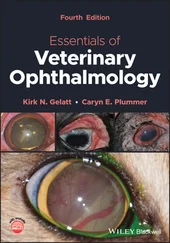1 ...6 7 8 10 11 12 ...18
Type III (Antigen–Antibody Complex) Hypersensitivity Reaction
Immune complexes are antigens bound to their antibodies. When excessive amounts of antigen are present in the body, more complexes than can be cleared efficiently by the body are formed. These complexes precipitate in tissue in large amounts and cause severe inflammation. The antigen–antibody complexes may remain at the initial site of attack or move through the bloodstream and lodge in distant locations such as capillaries or renal glomeruli. Once in the tissue, they trigger the accumulation of neutrophils, which release oxidants, inflammatory mediators, and enzymes that trigger additional inflammation and tissue damage. This type of hypersensitivity reaction is seen in many tick‐borne diseases and leishmaniasis, as well as autoimmune diseases such as systemic lupus erythematosus and vasculitis.
Type IV (Delayed or Cell‐Mediated) Hypersensitivity Reaction
Delayed hypersensitivity reactions involve Th lymphocytes, macrophages, and cytotoxic T lymphocytes. Delayed‐type hypersensitivities are induced by chronic intracellular infectious disease agents such as Mycobacteria spp. or Leishmania spp., as well as contact allergens. For dermatology, contact allergy is the perfect example of a type IV reaction. In contact allergic dermatitis, small molecules from plants or chemicals are absorbed into the skin. These molecules by themselves do not elicit a response from the immune system and are called haptens. Once these haptens attach to a host protein, this larger complex can then be recognized, processed, and presented as a complete antigen by Langerhans cells. During presentation to naïve T cells in the lymph node, the Langerhans cell releases cytokines that induce the formation of Th1 and Th17 cells. These cells then return to the skin and upon reexposure release Th1 cytokines and activate macrophages, causing the clinical signs associated with delayed hypersensitivity.
1 Eyerich, S., Eyerich, K., Traidl‐Hoffmann, C., and Biedermann, T. (2018). Cutaneous barriers and skin immunity: differentiating a connected network. Trends Immunol. 39: 315.
2 Marshall, J.S., Warrington, R., Watson, W., and Kim, H.L. (2018). An introduction to immunology and immunopathology. Allergy Asthma Clin. Immunol. 14 (Suppl. 2): 49.
3 Matejuk, A. (2018). Skin immunity. Arch. Immunol. Ther. Exp. (Warsz.) 66: 45.
4 Pasparakis, M., Haase, I., and Nestle, F.O. (2014). Mechanisms regulating skin immunity and inflammation. Nat. Rev. Immunol. 14: 289.
5 Richmond, J.M. and Harris, J.E. (2014). Immunology and skin in health and disease. Cold Spring Harb. Perspect. Med. 4: a015339.
6 Simoes Quaresma, J.A. (2019). Organization of the skin immune system and compartmentalized immune responses in infectious diseases. Clin. Microbiol. Rev. 32: e00034.
7 Smith, A.R., Knaysi, G., Wilson, J.M., and Wisniewski, J.A. (2017). The skin as a route of allergen exposure: part I. Immune components and mechanisms. Curr. Allergy Asthma Rep. 17: 6.
2 How to Get the Most Out of Your Dermatologic History and Examination
Michelle Woodward O’Gorman
Listen carefully and attentively to the owner.
It is difficult to diagnose many dermatologic diseases without a good history.
Since dermatologic histories can be long, clients should fill out a dermatology history form before their appointment.
Examine patients’ skin in a systematic way so no area is overlooked.
Be sure to record findings in a detailed manner.
Like many areas of veterinary medicine, dermatology relies on the history and physical exam to form a clinical picture. If time is dedicated to these early in a case, the clinician will have an easier time selecting and interpreting diagnostics later. A practiced dermatologist will frequently have a good clinical picture formed based on history alone, even before evaluating the patient. This can prompt the clinician to ask specific questions and more carefully evaluate certain areas of the body, although care must be taken to avoid tunnel vision.
Every dermatologic case should start with a complete evaluation of the patient’s history, which can often take longer to complete than the actual physical examination. The first part of this process should include a review of all previous medical records. Dermatologic patients frequently have extensive medical histories and often have been managed by multiple veterinarians/clinics, sometimes even at the same time. Obtaining and reviewing medical records prior to evaluating the patient are vital, but often overlooked. People’s memories are frequently incomplete or skewed, and records can provide firm information. For instance, owners may feel that their dog’s pruritus is not seasonal, but medical records may demonstrate that the patient has only required glucocorticoids during the spring and summer months for the previous three years. Medical records can also provide information about treatment successes and failures, disease progression, and previous clinical signs.
The next part of the history is gathering the client’s perception of the problem. Veterinarians only see patients for a short window of time at the appointment. Clients, however, are typically in the patient’s presence daily and will have a more complete picture of what the pet is experiencing. Begin gathering the client history prior to the appointment by providing a standard form that can be filled out and returned in advance (example in Figure 2.1). Review of this form and the medical record prior to the appointment maximizes the time in the clinic with the client and patient. The form can have a combination of closed questions (yes or no answer) and open questions where the client can formulate a response. Both question types can help to develop the complete history. The history should also be discussed with the client, as repetition can provide more detail and allow for clarification and confirmation of previous responses.
Given a complete history including both client and record information, a reasonable differential list can often be formed prior to evaluating the patient. However, the clinician should keep an open mind and not rush the physical exam. The following elements of a patient’s history should be considered, using information collected from a completed history form, discussion with the client, and the previous medical records.


Figure 2.1 Example of a dermatology history form for a client.
Current age and age of onset can be helpful in developing differential diagnoses (e.g. congenital disorders in young animals). The patient’s breed and coat/skin color can also be important when considering predilection for certain diseases. This is especially true for more obscure diseases that might be missed if the specific breed isn’t investigated. Sex, including whether a patient is intact or neutered, can also help to prioritize differentials.
In order to successfully manage a case, it is important to discover the client’s primary concern and address it, even if only through discussion and explanation. Clients can become frustrated if they perceive that they aren’t being listened to or if their pet’s main problem isn’t managed. For instance, a client may present with the chief complaint that their dog is shaking its head. If the veterinarian focuses instead on the severe skin infection that is also present, and does not address the ear infection to a level that satisfies the client, they may leave frustrated and disgruntled. Frustrated clients may not follow through with therapy at home or future appointments.
Читать дальше














